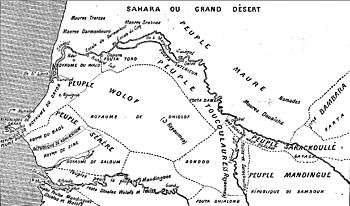Lat Jor
Lat Jor Ngone Latir Jop (Wolof: Lat Joor Ngoone Latiir Joop; French: Lat Dior Ngoné Latyr Diop; 1842–1886), son of Sahewer Sohna Mbay (Sakhéwère Sokhna Mbaye) and the Linguère royal Ngone Latir Fal (Ngoné Latyr Fall), Ngoné Latyr Fall was from the Wolof Dynasty of Paleen Dedd which ruled the two kingdoms of Cayor and Baol. Lat Joor was a nineteenth-century damel (king) of Cayor, a Wolof state that is today in south-central Sénégal. Lat Jor belonged to the Geej or Guedj Wolof maternal dynasty that has ruled Baol and Cayor for two centuries. The matriarch of that matriclan was the Wolof Lingeer Ngoné Dièye, a Princess from Tubé Dieye in Gandiol. Gandiol is a Wolof region in the north of Senegal that borders Mauritania.". Lat Jor was a direct maternal descendant of Lingeer Ngoné Dièye of Tubé Dieye .[1]

Conversion
Lat Joor was born a Muslim in the Muslim family of Sakhewar Fatma His grandfather Sakhewar Fatma Converted to Islam from the Wolof Islamic scholar of Coki Matar Ndoumé Diop . Lat Joor had a second conversion to Islam for political reasons to gain a political alliance with the Almamy of Rip, Maba Diakhou Bâ.
Conquests
Lat Jor led his troops beside Maba in the battle of Rip on 30 November 1865, at the battle of Pathé Badiane in 1864 and Ngol Ngol in 1865. With Lat Jor, Maba took part in the conquests of the states of Baol and Djolof. They, however, couldn't conquer the Serer Kingdom of Sine and were defeated at The Battle of Fandane-Thiouthioune (18 July 1867) by Maad a Sinig Kumba Ndoffene Famak Joof (King of Sine).[2][3]
Facing the French
At Kaolack in 1865, they combined forces with soldiers from Waalo, Ndiambour, and Ndiander to face the French fortifications of the governor Émile Pinet-Laprade but were repulsed.
After the French conquered Waalo, (re-appointed) governor Louis Faidherbe invaded Cayor in 1865 to stop the Damel's opposition to the construction of the Dakar to Saint-Louis railway. Dior is reported to have told the later French Governor Servatius:
"As long as I live, be assured, I shall oppose, with all my might the construction of this railway.[4]"
But the French defeated Lat Jor's forces at the battle of Dekheule on 26 October 1868, after Faidherbe's retirement. Lat Jor struck a deal for limited autonomy and re-installment in 1871. In response to further French expansion, Cayor rose again with Dior at their head, only to be defeated and be annexed again in 1879.
The Cayor kingdom was extinguished in its entirety on October 6, 1886.
The Legend of Lat Jor
Faidherbe is reputed to have said of Lat Jor's troops: "Ceux-là, on les tue on ne les déshonore pas." ("They can be killed but not dishonored"). This has been adapted as the motto of the Senegalese Army: "On nous tue, on ne nous déshonore pas".
In Dakar, there is a giant statue of Maalaw, the legendary horse of Lat Jor, near the great mosque.
Ancestry Chart of Lat Jor
| Sahewer Fatma Cub (Bar-Get) | |||||||||||||||
| Medun Sohna Nyan (Bar-Get) | |||||||||||||||
| Sohna Nyan (?) | |||||||||||||||
| Sahewer Sohna Mbay Jop (Bar-Get) | |||||||||||||||
| Sohna Mbay (?) | |||||||||||||||
| Lat Jor Ngone Latir (Damel-Teigne) | |||||||||||||||
| Lat-Degen Fari (Teigne) | |||||||||||||||
| Ma-Iseu Tend Jor Samba Fal (Damel-Teigne) | |||||||||||||||
| Jor Mahureja | |||||||||||||||
| Ngone Latir Fal (Linguère) | |||||||||||||||
| Jam Jeumb | |||||||||||||||
| Absa Mbunum | |||||||||||||||
| Aisa Jop | |||||||||||||||
See also
Bibliography
- Marie Casanova, Lat Dior : le dernier souverain du Cayor, ABC : Nouvelles éditions africaines, 1976
- Amadou Cissé Dia, Les Derniers jours de Lat Dior suivi de La mort du Damel, Présence Africaine, 1965
- Denys Ferrando-Durfort, Lat Dior : le résistant, Paris, Chiron, 1989, 45 p. ISBN 2-7027-0403-4
- Vincent Monteil, « Lat-Dior, damel du Kayor (1842-1886) et l'islamisation des Wolofs », in Esquisses sénégalaises (Wâlo, Kayor, Dyolof, Mourides, un visionnaire), Dakar, IFAN, 1966, 244 p.
- Mamadou Seyni M'bengue, Le procès de Lat Dior, D.A.E.C., 1970
Fiction
- Thierno Bâ, Lat-Dior – Le chemin de l'honneur, drame historique en huit tableaux, Dakar, Impr. Diop, 1970, 100 p.
References
- 1. Curry, Ginette. In Search of Maba: A 19th Century Epic from Senegambia, West Africa. Phoenix Press International, Maryland, USA, 2011..
- Duvernoy, G. L. (1833). Notice Historique Sur Les Ouvrages et la vie de M. Le B.on Cuvier/par G.L. Duvernoy. Paris :: Chez F.G. Levrault ;. pp. Page 541.CS1 maint: extra punctuation (link)
- Alioune Sarr, Histoire du Sine-Saloum. Introduction, bibliography et Notes par Charles Becker, BIFAN, Tome 46, Serie B, n° 3-4, 1986–1987. pp 37-39
- Diouf, Niokhobaye. "Chronique du Royaume du Sine." Suivie de notes sur les traditions orales et les sources écrites concernant le Royaume du Sine par Charles Becker et Victor Martin. (1972). Bulletin de l'Ifan, Tome 34, Série B, n° 4, (1972). (pp 727-729, pp 16-18)
- BBC. The Story of Africa: Railways.